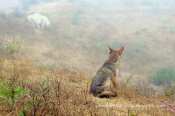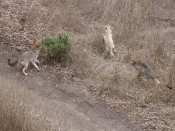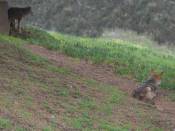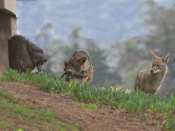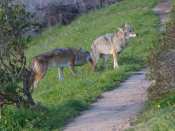This posting is a slightly revised and expanded version, with photos, of what was originally written for, and posted on, Bernalwood.com on May 27th.

coyote at dawn
We have coyotes in most of our parks here in San Francisco, and most folks I’ve spoken with are thrilled about it! Enjoy it and respect its wildness! At the same time, there are some people, especially pet owners, who are not so thrilled. Here is some information I’ve put together about coyotes, much of it based on my own observations, as a response to concerns and comments which have appeared in some of the social media recently. This is information that applies to urban coyotes everywhere, not just here in SF.
COYOTES ARE TERRITORIAL AND LIVE IN FAMILIES

coyotes in our parks
Most parks in San Francisco have one stable resident family, or a loner. Coyotes are not “pack” animals of unrelated individuals. Families “claim” territories which they “own” from which they exclude other coyotes — this is what keeps the population density down. They trek through the neighborhoods every night, during the early morning or early evening hours — and, more rarely, during the brightest hours of the day — marking their territories to keep other coyotes out and looking for hunting opportunities. Studies show that in urban areas, there is generally about one coyote per square mile — a family of 4 would require about 4 square miles. You will always be seeing the same individual coyotes in any particular area.
Although we have parks with loner coyotes, most parks have mated pairs with families. Coyotes mate for life, and both parents raise the young. Coyotes mate in January or February and produce young in April — births occur only once a year.
The number of family members fluctuates up and down continually over time. In one park, it went something like this: 2-5-3-4-2. The fluctuation is due to new pups, and then to their dispersal or deaths. There is only about a 30% survival rate of pups during their first year — disease and nutritional issues take their toll.
When it’s time for youngsters to “disperse”, the parents will drive them out, or they may just pick-up-and-go. This usually occurs between one and two, and sometimes three years of age, and it occurs throughout the year — there is no “dispersal season”. However, the breeding adult pair will remain in the same territory over many years. Interestingly, wolves will actually kill their own kin in order to preserve their own statuses and territorial rights. I’ve not seen this in coyotes, but I have seen the altercations that drive coyotes out of their birth territories.
Cars are urban coyotes’ chief cause of death — please drive carefully! They often trek on our traffic grid — it’s often the “path of least resistance”. A few days ago, in our Diamond Heights neighborhood, a car swerved right into someone’s house to avoid hitting a coyote during the early morning hours.
MORE ASSERTIVE OR INSISTENT BEHAVIOR

coyote shows her anxiety and displeasure with a dog by jumping up and down
As the individuals in a family mature, some of them may go through phases of what might be called more “assertive” or “insistent” behavior, such as: following or running in the direction of a dog. During pupping season, the assertiveness is strongest, with coyotes even approaching and possibly even nipping at a dog’s haunches. These are coyote “messaging” behaviors: coyotes want dogs to move on and to know the territory is taken. These behaviors don’t “define” a coyote, and they don’t last. Think of these as phases in a teenager’s life, or in a parent’s life — there’s an ebb and flow to behaviors for each coyote, often based on what is going on within the coyote’s individual family: Are there new pups? Is there increased sibling rivalry? Are parents having issues with the offspring, or trying to get one to disperse? I’ve seen no evidence to indicate that such behaviors build up towards more aggressiveness. Many of the more apparently “assertive” behaviors, both in juveniles and adults, are based solely on circumstances and happenstance encounters, so keep your distance.
SIGHTINGS

trekking through the neighborhood
A substantial increase in “sightings” doesn’t necessarily translate into a spike in the coyote population, though this is what many people assume. Again, increased sightings could be due to their current family dynamics which may cause individuals to wander farther afield.
Unusual weather conditions can have an effect on sightings. San Francisco has just been through a four-year drought. Drought conditions cause coyotes to hunt further afield and for longer hours. They become more visible to humans and more prone to incidents during these times when their activity overlaps with ours. It takes 8 full months for an ecosystem to recover from a drought.
Human changes to the environment, including new construction, will affect coyotes in an area. In San Francisco, coyotes may be lingering longer in neighborhoods recently, and therefore be seen more, because of the current program of thinning and eliminating dense and protective thickets in the parks, reducing coyotes’ normal secure habitat. Stopping the destruction of the habitat, and compensating for the exceptional weather or drought in various ways until the ecosystem has recovered, both are steps that could be taken to reduce sightings, and possible dog/coyote encounters, and coyotes’ spending the past-twilight hours in neighborhoods.
FEEDING

feeding coyotes is not good
Please don’t feed the coyotes. Feeding breaks down the barrier that keeps coyotes wild. If they become food conditioned — which is different from “habituation” (see below) — problems could develop, including approaching people, which increases the chances for a negative incident to occur. Feeding them also encourages them to hang around yards where people don’t want them.
Coyotes are opportunistic eaters, which means they can eat almost anything, but their preference in San Francisco is for gophers, squirrels and voles, which they eat whole: they need the meat, muscle, bones, fur — all of it — to nourish themselves properly. They also eat fruit, nuts, bugs, weak or juvenile raccoons, skunks, opossums, and possibly snakes. They prefer their whole foods over human-made foods, but if that human food is available, they’ll try it. And they will eat the occasional cat or small dog if circumstances are right — they don’t know who is a pet and who isn’t. Don’t create the right circumstances that could add your pet to the food chain. Please protect your pets by not allowing them to roam free and by supervising them closely when out-of-doors.
As top predators to an area, coyotes have helped rebalance the environment: they control rodents and some mesopredators, such as opossums, skunks and raccoons.
HABITUATION

a habituated coyote is not a dangerous coyote
Urban coyotes do not “fear” humans — that is an incorrect term. Rather they are “wary” of humans. This means that, although a coyote won’t flee lickety-split in fear when they see a human, they nonetheless will maintain distance and not approach us. And we, in turn, need to respect them and their wildness by keeping as far away from them as we can. “Habituation” is a normal progression in urban areas — you cannot prevent it because you cannot stop coyotes from seeing humans on a daily basis — they get used to seeing us. A habituated coyote is not a dangerous animal. In fact, the term “habituation” was first used to describe bears as being more dangerous if they got used to people and lost fear of us. This assumption has been turned on its head: scientists now know that bears who are habituated tend to ignore humans, whereas bears who have never seen humans become reactive. In Africa, to make gorillas less reactive to humans, for the tourist trade, people purposefully habituate them — they become less dangerous.
Coyotes also habituate to “hazing” tactics, which is why such tactics should not be used if a coyote is way out in left field. Scaring off a coyote should be used sparingly. It should be reserved for when a coyote has come too close to you. It is a useless tactic unless the coyote is closer than 50 or so feet to you, which generally delineates its critical distance for discomfort.
Note that “habituation” is different from “food conditioning”. When visibly feeding or hand-feeding a coyote, you are conditioning it to approach humans. Don’t feed coyotes.
THE ISSUE IS WITH PETS

suspicious coyote mother and a dog owner not being vigilant
Whereas coyotes don’t approach humans, dogs are a different story because of territorial issues and because of prey issues. In many ways, coyotes and dogs look alike, but coyotes and dogs are naturally antagonistic towards each other. Remember that coyotes keep other coyotes out of their territories. Coyotes are also both curious and suspicious of dogs: they may feel compelled to come in closer to investigate. Always supervise your pets to prevent incidents: the minute you see a coyote, leash and go in the other direction. Most dogs have a tendency to go chasing after coyotes. Please don’t allow your dog to do this.

coyote messaging a dog — the dog should have been kept away from the coyote
Coyotes have approached dogs. If they get too close, they could either grab a small dog or “message” a larger dog who the coyote considers a threat to its territory or its personal space. They can only do this when they get close enough. Don’t let them. You can prevent an incident by keeping your dog away from coyotes in the first place, by leashing when you see one, and by walking away from it. It’s no different than when you encounter a skunk with its tail up: keep your dog off of it, and move away from it.

coyote following
IF, inadvertently or by surprise, a coyote gets too close, that is when to scare it off, otherwise just walk away without running: see http://baynature.org/article/how-to-get-along-with-coyotes-as-pups-venture-out/
Coyotes may follow dogs to find out what the dog is doing and where it is going (they do the same to non-family coyotes). If you and your dog are moving away from the coyote, and away from any denning site, the coyote soon will no longer follow. If you don’t want the coyote to follow at all, toss a small stone in its direction (not at it), and/or approach it (but don’t get too close) using your own blatantly angry body language and angry yelling. Noise alone, or waving flailing arms, is not always effective in making a coyote move — something has to move towards the coyote. And it isn’t going to help if you are too far away. You’ve got to get within the coyote’s critical distance — at most 50 feet — and you have to be assertive about it. Walking towards the coyote while slapping a newspaper viciously on your thigh works, but tossing stones towards it is probably more effective. However — and this is a very important “however” — if the coyote doesn’t budge, it is probably protecting a nearby den site. In this case, turn around and leave. Do not provoke an incident. See the above link in Bay Nature.
It’s always best to be proactive in keeping a coyote away. The minute you see a coyote, leash up and move away from it, and know how to shoo it off effectively if it comes closer to you than 50 feet.
Note that practically all scratches or bites by coyotes to humans are due to feeding the coyote, or to an owner getting him/herself between a coyote and a pet, so don’t do these things. And, never run from a coyote: this activity actually initiates the chase response in a coyote who may also nip at your heels. They also sometimes nip at car tires when the car is in motion. The phenomena is called “motion reactivity”.
ENCOUNTERS CAN BE SCARY

Encounter: the dog chased the coyote and the coyote stood up for itself
Encounters CAN be scary if you are unprepared and don’t know what to expect or what to do. Please learn what coyotes are like, not what you think they “should” be like — for instance, that they don’t “fear” humans but are “wary” of them, and not that “coyotes should be heard and not seen”. By knowing their true normal behaviors, and by knowing what to do *IF* they approach your dog, you will be informed and you will not be so fearful. For starters, watch the video, Coyotes As Neighbors: https://youtu.be/euG7R11aXq0, which will spell out normal coyote behavior and what you can do to keep coyotes away from a pet.
MANAGING COYOTES
The number one method of managing coyotes for coexistence is through human education and human behavior modification: that is what this posting is trying to help with. These have been shown to be extremely effective. The City of San Francisco has been lax in putting out signs or getting educational material to folks. Some of us have been filling the void, getting material, information and guidelines out to people, but as individuals or as small organizations, we have not been able to reach everyone. Please visit coyotecoexistence.com for specific information, and coyoteyipps.com.
Many cities have coexistence policies — they all work when folks abide by the guidelines. BUT, as with car driving laws, even if you know them and follow them, there will be some fender-benders that might be frightening. We have fewer than 100 coyotes in the City; the number of dogs is in the 250,000s. There is bound to be an incident now and then.
The number of real coyote incidents in the City is not many. There have been less than a handful of dog fatalities by coyotes — all were unleashed small dogs in known coyote areas — all were preventable. There have been many incidents of people being frightened and reporting “attacks” on their dogs. Few if any of these attacks were reported on a questionnaire which would tease out what actually occurred. Instead, these incidents have been spelled out on the social media with warnings of doom that is awaiting us all.
Most of the sightings of coyotes have been reported as charming. But there have been some fearful encounters, and recently groups of dog owners in some of the parks have turned decidedly against them. Social media tends to perpetuate, spread and amplify the fears, and encounters are inevitably worded as deliberate “aggressive attacks”. For instance, recently, there was a report of an attempted “attack” on a dog at 5:30 in the morning. However, a lone coyote, who weighs 35 pounds, is not going to “attack” a 130 pound Mastiff… Coyotes may watch dogs, follow, or hurry in your direction for many reasons, including curiosity, or investigation. They may jump up and down because of anxiety. These are not “attacks”, nor are they “attempted attacks”. Hopefully, by learning about coyotes, we can diminish the very real feeling of fear which comes from not knowing what is going on.

a coyote standing on a pathway, watching
Our Animal Care and Control Department has had many people report “aggressive” coyotes: but when questioned further, the majority of these reports were of a coyote just standing, or doing nothing but looking at the purported victim.
Two years ago I watched a man, straight faced, tell me that he had been frightened “out-of-his-wits” by a monster 100-pound coyote just a few moments before seeing me. He was visibly shaken. He hadn’t seen me watching the whole incident a little way down the path. The incident involved his dog chasing a coyote. The coyote turned around to face the dog. When the dog ran back to its owner, the coyote proceeded on to where it had been going. But the owner was left frightened, and justified his fright by saying it was a “monster 100-pound coyote”. If the dog had been leashed, the incident would not have happened. It happened in a park where everyone knows there are coyotes.
If you have questions, or if you want help with specific issues, please contact me or anyone at coyotecoexistence@gmail.com
























